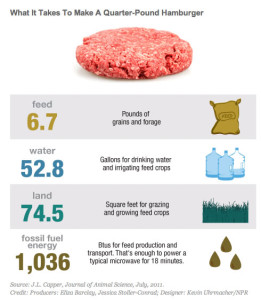 Producing animals for consumption takes one of the biggest tolls on our environment and is increasing as developing countries and the earth’s population grows to new heights. Today about 70 billion farm animals are produced annually for consumption with approximately 2/3 raised in factory farms under harsh and abnormal conditions. What this is doing to the earth is more damaging than all transportation impacts combined. To start with, it takes a lot of plant calories to produce the same amount of meat calories. Through the long process of raising, slaughtering and transporting livestock, this market is contributing to 75% of annual deforestation, while polluting water from pesticides and fertilizers used to grow feed instead of crops that directly feed the human population.
Producing animals for consumption takes one of the biggest tolls on our environment and is increasing as developing countries and the earth’s population grows to new heights. Today about 70 billion farm animals are produced annually for consumption with approximately 2/3 raised in factory farms under harsh and abnormal conditions. What this is doing to the earth is more damaging than all transportation impacts combined. To start with, it takes a lot of plant calories to produce the same amount of meat calories. Through the long process of raising, slaughtering and transporting livestock, this market is contributing to 75% of annual deforestation, while polluting water from pesticides and fertilizers used to grow feed instead of crops that directly feed the human population.
Like so many other economically efficient yet environmentally awful routines America has, livestock farming is another sector that needs to be reformed… or everyone needs to become vegetarian or vegan. The environmental impacts of meat consumption are no small thing.
- Consuming less meat, especially red meat like beef and lamb, reduces your carbon footprint better than buying a Prius would!
- Both methane and nitrous oxides (byproducts of livestock waste) have drastically more climate change impact than CO2 over the next couple decades.
- More land would be available for direct food crops in a growing population
- Reforesting lands that have been stripped of their vegetation to make room for cattle
- Feeling good about yourself for being sustainable!
Although consuming less meat would help decrease the negative effects of livestock farming, the farmers themselves have the ability to do their big part as well. According to a report by FAO, the most GHG emitting step in the livestock farming process was feed production and processing, which accounted for 45% of the total GHG emitted by livestock farming. Using low-emission feed or keeping the livestock grass fed, which eliminates transportation costs for the feed, is a large change that could be made to drastically reduce GHG emissions into the air. Other changes include the use of energy saving equipment, recycling the manure produced from cattle instead of producing fertilizer and improve graze and farming management to use rotational land use and crop harvesting. These are just a few necessary changes that need to be made in the livestock farming business which effects would drastically lessen greenhouse gas emissions, pollution and deforestation.
Either our diet or our demand for sustainable livestock farming needs to change and it starts with the consumer. If eating meat is too good to give up then, try eating less meat and choosing the more climate-friendly options. Some animals are more efficient at converting plant calories into meat calories than others and therefore have impacts relating to feed production. If you have to get beef, choose grass-fed beef which eliminates the production and transportation of grain feed. These small changes can make a big difference if people can take the leap and change.



